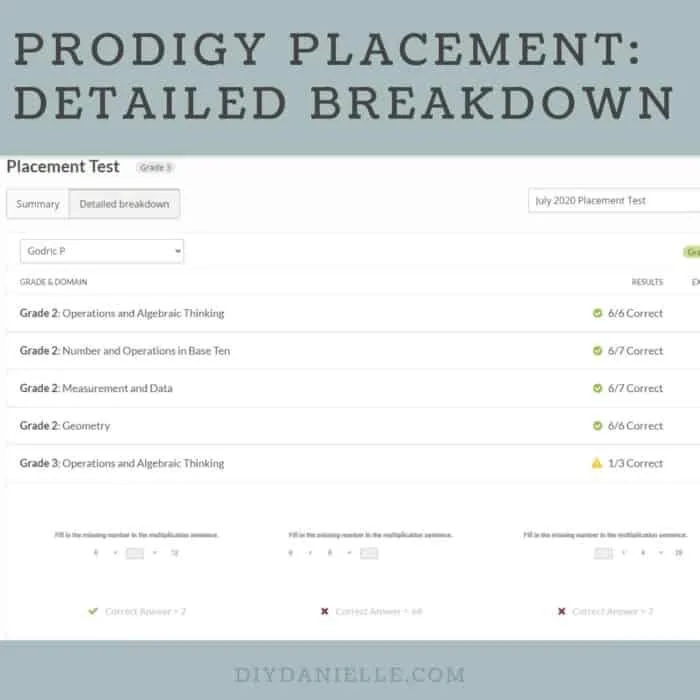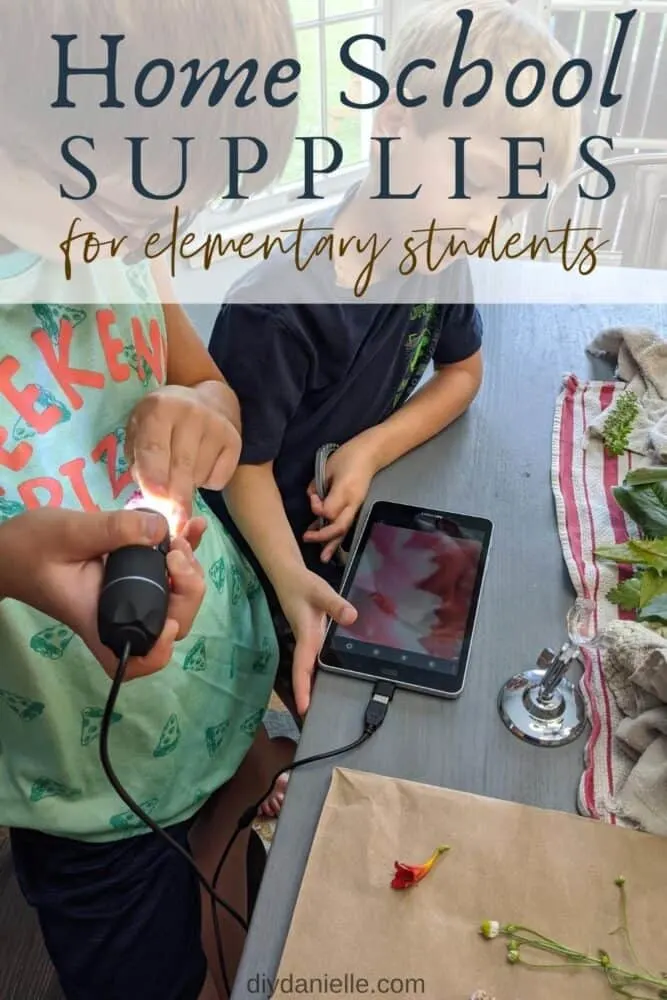
Homeschooling supplies and useful tools for elementary aged children. Some simple items that will make homeschooling your child easier this year.
This post may contain affiliate links which may earn me commissions should you click through them and take certain actions. As an affiliate for Amazon, Cricut, xTool, Home Depot, and other sites, I earn from qualifying purchases. Please DIY carefully. View my full legal disclosures here.
Please read the whole post so you don’t miss any important information!
I’ve been researching curriculum and different products to help teach my sons, ages 7 and 9, after we withdrew them from our public school system to homeschool for the 2020/2021 year. Withdrawing them was a TOUGH choice.
I love the public school system and adore having quiet time at home to work. I really miss the routine of going to school each day… I enjoy walking out to the bus with the kids and picking them up when they come home. And I value the relationships that kids form with their teachers and other staff at school. It’s good for them to be around other adults.
But our county went 100% digital until January 28, 2021. I can’t blame them and I think it was the right call. The kids are constantly sick during the school year and kids are germ magnets. But the things I value MOST about school are gone this year. There won’t be peer interaction and the teacher student relationship is going to be pretty minimal behind the screens of a computer.
When it boiled down to it, the school’s plan to have the kids on a computer for 7 hours of online learning each day was just too much for me to supervise. We have a VERY busy 3 year old too. Homeschooling seemed like it would be less time intensive and better quality.
Not only that, but I’m tired of riding the ‘RonaCoaster. The school system said, “This is the schedule and we will adjust when we see how it goes.” We did this in the Spring. The school system changed things, never consulted teachers, and overall didn’t see inclined to try to meet the needs of the kids, families, and teachers.
I feel like the government and political leaders are trying to keep schools and education the EXACT same as “normal”… they’re trying to force everything to work the way it did before, but nothing about right now is normal.
It’s not working and honestly the process is exhausting for me to plan around. And I want some stability for my kids and my family. I turned in the paperwork to remove my kids from the school. It was a sad day and the day after sending the paperwork in, I joked that I wanted to break into the post office that evening to try to steal my letter back.
I started homeschooling in August. The kids had been mostly off school since February and based on the assessments we did, they were falling behind. I wanted to get situated and figure things out week by week. Each week I make adjustments to my plans and schedule to accommodate what works or doesn’t work for us.
So far we’ve been homeschooling for three weeks and I’m (mostly) enjoying it. I’m exhausted, but it’s fun and interesting to direct my sons’ learning.
I realize that there are a lot of parents in the same situation. Lots of parents are seeing schools go virtual. Some are withdrawing their children because they don’t want the risk of in-person learning. I was speaking to a leader of a local umbrella program in Maryland and she said that homeschooling numbers were up 300%, and that was in July. I’m interested in seeing what those numbers look like in September and October.
I’ve been putting together a list of resources that I have found helpful for teaching my kids so far. We’ve done some fun activities too and I’ll probably write up a separate post about that.
Table of contents
Assessments
Start by doing some assessments for your children to determine where they should be placed, particularly for reading and math.
My 3rd and 1st grade kids weren’t able to pass kindergarten money math problems on an assessment but they were in advanced math at school. So I decided we should catch up on money.
These four books were all at Costco in Frederick and seem like they may keep us busy this year, even without another curriculum. They were each under $10.
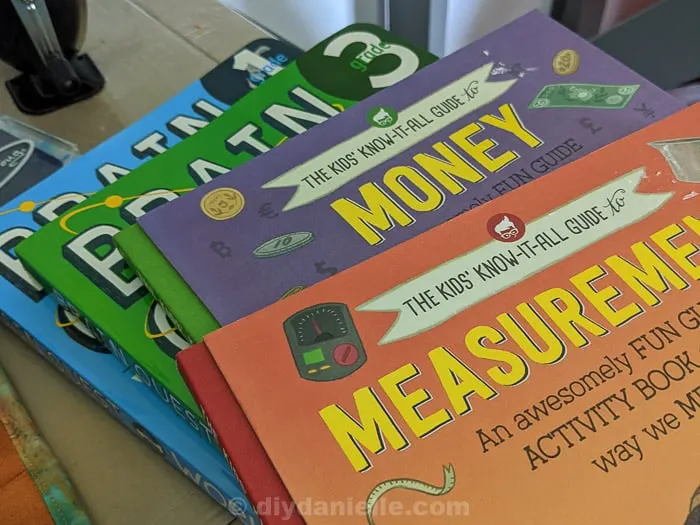
The boys are also playing the free math video game Prodigy. There’s a paid version but so far, they adore this game and the free version works. The game is a bit of a role-playing video game; to fight battles, they have to answer math questions correctly to score a hit. I registered as a teacher and it emailed me what grade level they ranked at for math.
Early on, and throughout the game, the game assesses them and gives you reports of where they rank. This is the summary and this is telling me that I may want to work more on the items he’s scoring for grade 3 on.
On the detailed breakdown, you can see what they get right and wrong. This is really useful. As you can see below, my son is having more trouble with operations and algebraic thinking than other areas.
As a homeschooler, I can address THAT TOPIC instead of wasting time on measurement and data. And over the course of the year, I can continue to review his progress and see what he needs help with. This is SUPER helpful.
Also assessing him is sneaky because he likes the game and he doesn’t know it’s happening. It’s also not very time intensive for me to monitor; I just ask them to do 30 minutes of Prodigy and 30 minutes of a reading game per day.
For reading, we’re using a game called Reading Eggs. My 3 year old enjoys the little guy version of this. This also has an assessment on there, but the amount of information they give me for the assessment is different depending on the age of the child. Kaden is in Reading Eggs, Age 3-7 and has a much more detailed report than Godric, who is in Reading Express 7-13. Tristan is doing the Junior Reading Eggs for Ages 2-4 and I don’t think there’s a report for him.
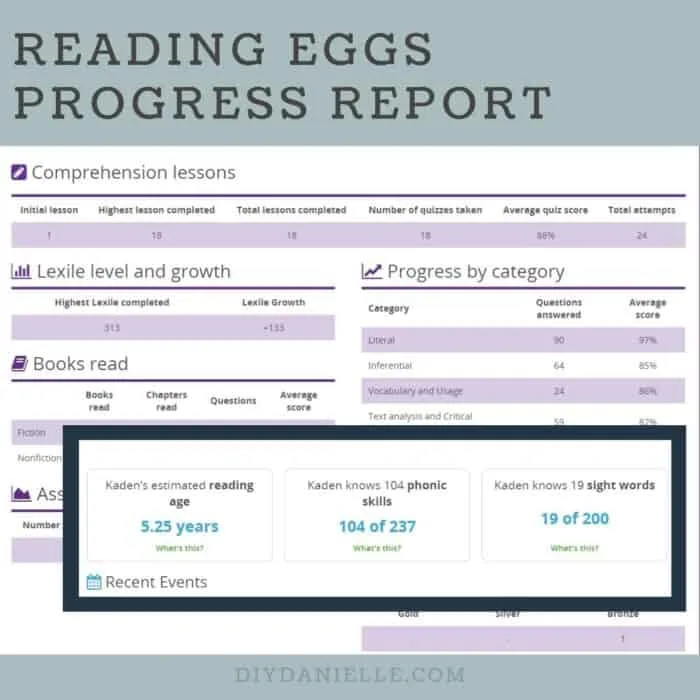
Don’t panic about where your child assesses at… remember that most kids had a huge gap since they were last in school. It may take a couple of months of consistent learning to catch back up.
I have my kids use both programs for 30 minutes a day. I may cut down on that… I’m still trying to get a feel for what is too much or too little.
Supplies for Elementary Age Homeschooling
This is the Amazon list of supplies that I’m using to homeschool elementary school kids if you just want photos to browse through.
I’m going to break down some specific items and why I chose them below.
Item 1: Learning Resources Pretend and Play, Play Money, Counting, Math, Currency, 150 Pieces, Ages 3+
Based on the assessments my children did for math, they were able to do high level math, but they weren’t given a good foundation for money or measuring. While this is something they’ll likely pick up out of necessity over time, I think they’ll be fun and easy to teach the kids about this year.
I purchased the pretend play money so we could practice giving change for purchases. I’ve used real money before too, but we have a toddler so I decided fake money might be a good idea. This is an activity we did this Spring… you can use slips of paper… dry erase makers didn’t come off these IKEA plates easily.
I wanted to make sure we were teaching time as well so I picked up this clock. The paper clocks you can manipulate are probably a bit more educational, but now we’ll have a clock for the room.
Item #3: Reading Skills: Grade 3 (Flash Kids Harcourt Family Learning) Paperback – July 19, 2004
I bought reading skills and language arts books from this company for both 1st and 3rd grade. I skipped handwriting because I want them to practice handwriting as part of other assignments. I really like these so far and feel they will be a great guide to follow for language arts this year.
Item #4: French I, Grades K – 5 (Skill Builders) Paperback – January 3, 2011
We are hoping to welcome a French au pair at some point… COVID has caused some snags for that, but the plan was for me to work full time and have her watch the naughty toddler while the big guys were at school. Now we’re just hoping to welcome her so I can work AND homeschool.
Regardless, I love French and want the children exposed to languages early. I’ve introduced them to some French, Spanish, and ASL (American Sign Language). Because we potentially have someone who can speak the language with them fluently this year, I decided on French. But there are booklets for other languages as well. I think ASL is a great option. We’re going to dedicate 15 minutes a day to French.
Here is a post I wrote a while ago on how to immerse your children in other cultures without leaving the country.
We created the corner desk for their homeschool area with the IKEA cabinets. The bottom has a filing section. Our county requires that homeschoolers create a portfolio to bring to reviews. I have a binder for each kid to organize my notes, but I also want to organize their work by subject in their filing cabinet. Each kid will be able to place graded assignments in the cabinet and I’ll be able to pull out a few examples from each subject for each review.
Target actually sells some really pretty hanging file folders too that I picked up for myself.
Technically this is a gift for my almost 3 year old, but I think it will be educational for all the kids.
We had an illuminated globe when I was a kid and it was one of my favorite adult items in our home. I loved looking at all of the different places and seeing where we were in the world. I plan to cover some geography with the boys this year so a globe seemed like a fun thing to get.
Item #8: Mad Libs
One thing my son’s 2nd grade teacher did last year was introduce them to Mad Libs. I remember LOVING these as a kid and he did too!
Honestly, learning the difference between adjectives, nouns, and verbs is boring… if this can make it fun, I’m calling that a win!
Item #9: Board Games
There’s a really cool group dedicated to teaching using board games called “Gameschooling.” You can’t teach an entire school year with games, but they certainly help.
My kids LOVE board games so we try to use them as possible in an educational way. Scrabble, Monopoly, Site Word Bingo, Ticket to Ride, and many others teach everything from spelling to money to geography.
Item #10: Snap Circuits
We’ve had these forever, but I may work Snap Circuits into our science curriculum. They really enjoy putting them together and the manual gives them detailed instructions on how to do different things with the circuits.
Item #11: Using YouTube and/or TV Shows
My kids requested that we use Magic School Bus for some topics. I also use YouTube pretty frequently to show the boys how things work. I really like seeing videos of how a product is turned into another product, for example. It’s a great way to educate them without being too boring.
For example, the other day we learned how sugar is harvested from sugar cane. I read aloud at dinner about what climate sugar grows in and why, and then showed them two YouTube videos. One was “Sugar, How It’s Made” and the other was, “Make sugar handmade by primitive people.” It’s a good 20 minute science lesson for each topic you pick.
We also watched videos on the French Revolution, Jane Goodall, and how electricity is generated from coal vs. green energy sources.
Item #12: Library Card
Our library is closed for walk ins right now, but we’re able to order online for contactless pickup. I try to pick up a variety of books from the non fiction section. Usually some ‘how things work’ science books, biographies, and history in the form of stories are interesting to my kids.
There’s a few book series that I like:
- “You Wouldn’t Want to be…” Series: History : This is a series of history books that talk about different events or people and discuss why those times kinda sucked. Lots of illustrations and real talk. Saw a review that said one book was a bit whitewashed, but I’m not sure I’ve seen that in the other books I’ve read in the series. Either way- I bring up topics like that when we’re reading so I feel like I can supplement that type of information easily. The series is brutally realistic so proceed with caution if your kids are sensitive.
- Ordinary People Change the World Series, Biography
- Who Was— Series: Biography
- 600-700 Area of the Library seems to be a lot of “how it works” books. What is Gravity? How Do Jets Work? Etc. Pick subjects your kids love… mine love reading about drones and robots!
- Tadpole books has a series of early reader books about animals, animal babies, and other science type topics. Ie. “Animal Parts Smarts: Horns,” “Forest Babies: Rabbit Kits,” and “Outdoor Explorer: I See Rocks.” I borrowed these all from the library to include as part of our 30 minutes of independent reading time each day.
Item #13. Microscope
I have a really old microscope that I thought I’d use, but looking through the eye piece drives me nuts. My 9 year old wanted us to buy him this CHEAP “microscope” back in Spring, but I told him to buy it himself. SO MANY REGRETS. He bought it himself and it’s AWESOME. It takes great photos and video, plus everyone can see the images on the computer/tablet so it’s GREAT for doing activities. My friend got what looks like the IDENTICAL microscope for less money ($17), but just check both prices because y’all know Amazon… prices shift.
I was going to use it for farm stuff (checking animal fecals for worms), but it isn’t quite what I need for that. I’m looking into a more expensive microscope for that. If you think you need something higher powered, AM Scopes has simple microscopes that you can purchase a digital adapter for. They have a digital lens that can be attached to the microscope for a similar function to the one we have.
Computer Programs for Elementary School Kids
My kids used Lexiacore and Dreambox through their school system. I am assuming we will lose access to those programs when we transition to homeschooling. Although we could possibly still make home accounts, I wanted to try something else. They spent a LOT of time on those two programs last year when schools closed and a change seemed like a good idea.
My cousin recommended trying the free version of Prodigy as a math game that would work for both of my sons. You can buy a membership, but it’s not necessary. My kids LOVE it. The game plays like an RPG (feels a bit like Pokemon) where you get into battles and each time you cast a spell, you either succeed or lose with the hit based on if you get the math problem right. I can go on my teacher dashboard for this and see what the kids are deficient or excelling in. For example, I can see they’re not doing well for measuring. I did a math assessment for them through another program and discovered they’re also deficient in money. This year I’ll continue to teach them normal math for their grade level, but I definitely want to have some dedicated time for measurements and money.
Want to give it a try? Sign up for Prodigy using my referral link.
Reading Eggs is another program you can do, except for reading.
We also looked at Beast Academy for math, but Kaden is too young for it so I decided to skip it. I’d rather streamline as much of this process as possible so we aren’t logging into a million different things.
Mission US is a FREE website where you can play games about history. You play as a character in the 1770 Revolution, 1848 The Antebellum Era, 1929 The Great Depression, 1866 Westward Expansion, 1907 Immigrant Experience, 1941 World War II. You explore their life, how the historical events played out and how they impacted your characters, and how the events impacted the character’s life (and the life of their children and grandchildren).
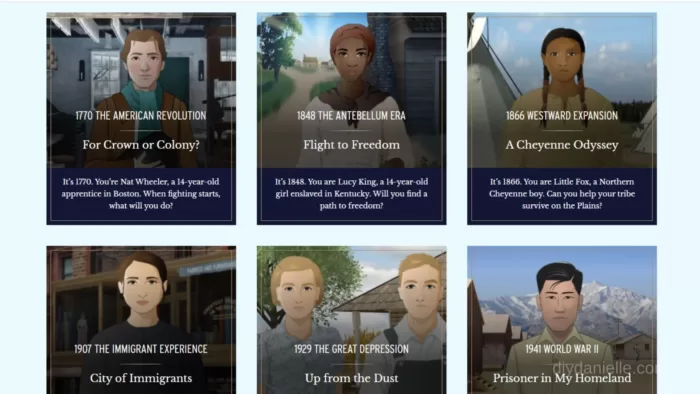
DIY Projects that will be useful for homeschooling:
- Corner desk with storage drawers
- This magnetic wall has been useful for doing geometry related tasks with Magnatiles.
- Kids Masks for field trips
- DIY pencil case
- DIY pen/pencil holder that is a bookmark and attaches to journal
I hope this was useful to get you started on your homeschool journey! If you are working too, here are some tips for working from home with kids!
Please share and pin this post! If you make this project, share it in our Stuff Mama Makes Facebook Group. We have regular giveaways for gift cards to craft stores. You can also tag me on Instagram @doityourselfdanielle; I love seeing everything you make!

Check out my Google Web Story: Best Affordable Homeschool Supplies for Elementary Aged Kids


